
Illustrative Math Alignment: Grade 6 Unit 1
Dividing Fractions
Lesson 5: How Many Groups? (Part 2)
Use the following Media4Math resources with this Illustrative Math lesson.
| Thumbnail Image | Title | Body | Curriculum Nodes |
|---|---|---|---|

|
Math Example--Arithmetic--Division and Unknown Factors: Example 2 | Math Example--Arithmetic--Division and Unknown Factors: Example 2TopicArithmetic DescriptionSimplify 24 ÷ 8 by using the inverse operation of multiplication. The example illustrates the method of column multiplication. The caption explains the process step-by-step, emphasizing the sequential multiplication and any necessary regrouping. In general, column multiplication is a foundational arithmetic skill that develops a student's ability to handle larger numbers systematically. Examples in this collection present varied scenarios, building confidence through exposure to different configurations of numbers. |
Division Facts and Multiplication Facts |

|
Math Example--Arithmetic--Division and Unknown Factors: Example 2 | Math Example--Arithmetic--Division and Unknown Factors: Example 2TopicArithmetic DescriptionSimplify 24 ÷ 8 by using the inverse operation of multiplication. The example illustrates the method of column multiplication. The caption explains the process step-by-step, emphasizing the sequential multiplication and any necessary regrouping. In general, column multiplication is a foundational arithmetic skill that develops a student's ability to handle larger numbers systematically. Examples in this collection present varied scenarios, building confidence through exposure to different configurations of numbers. |
Division Facts and Multiplication Facts |

|
Math Example--Arithmetic--Division and Unknown Factors: Example 2 | Math Example--Arithmetic--Division and Unknown Factors: Example 2TopicArithmetic DescriptionSimplify 24 ÷ 8 by using the inverse operation of multiplication. The example illustrates the method of column multiplication. The caption explains the process step-by-step, emphasizing the sequential multiplication and any necessary regrouping. In general, column multiplication is a foundational arithmetic skill that develops a student's ability to handle larger numbers systematically. Examples in this collection present varied scenarios, building confidence through exposure to different configurations of numbers. |
Division Facts and Multiplication Facts |

|
Math Example--Arithmetic--Division and Unknown Factors: Example 2 | Math Example--Arithmetic--Division and Unknown Factors: Example 2TopicArithmetic DescriptionSimplify 24 ÷ 8 by using the inverse operation of multiplication. The example illustrates the method of column multiplication. The caption explains the process step-by-step, emphasizing the sequential multiplication and any necessary regrouping. In general, column multiplication is a foundational arithmetic skill that develops a student's ability to handle larger numbers systematically. Examples in this collection present varied scenarios, building confidence through exposure to different configurations of numbers. |
Division Facts and Multiplication Facts |
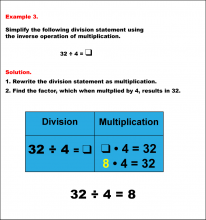
|
Math Example--Arithmetic--Division and Unknown Factors: Example 3 | Math Example--Arithmetic--Division and Unknown Factors: Example 3TopicArithmetic DescriptionSimplify 32 ÷ 4 by using the inverse operation of multiplication. The example illustrates the method of column multiplication. The caption explains the process step-by-step, emphasizing the sequential multiplication and any necessary regrouping. In general, column multiplication is a foundational arithmetic skill that develops a student's ability to handle larger numbers systematically. Examples in this collection present varied scenarios, building confidence through exposure to different configurations of numbers. |
Division Facts and Multiplication Facts |

|
Math Example--Arithmetic--Division and Unknown Factors: Example 3 | Math Example--Arithmetic--Division and Unknown Factors: Example 3TopicArithmetic DescriptionSimplify 32 ÷ 4 by using the inverse operation of multiplication. The example illustrates the method of column multiplication. The caption explains the process step-by-step, emphasizing the sequential multiplication and any necessary regrouping. In general, column multiplication is a foundational arithmetic skill that develops a student's ability to handle larger numbers systematically. Examples in this collection present varied scenarios, building confidence through exposure to different configurations of numbers. |
Division Facts and Multiplication Facts |

|
Math Example--Arithmetic--Division and Unknown Factors: Example 3 | Math Example--Arithmetic--Division and Unknown Factors: Example 3TopicArithmetic DescriptionSimplify 32 ÷ 4 by using the inverse operation of multiplication. The example illustrates the method of column multiplication. The caption explains the process step-by-step, emphasizing the sequential multiplication and any necessary regrouping. In general, column multiplication is a foundational arithmetic skill that develops a student's ability to handle larger numbers systematically. Examples in this collection present varied scenarios, building confidence through exposure to different configurations of numbers. |
Division Facts and Multiplication Facts |

|
Math Example--Arithmetic--Division and Unknown Factors: Example 3 | Math Example--Arithmetic--Division and Unknown Factors: Example 3TopicArithmetic DescriptionSimplify 32 ÷ 4 by using the inverse operation of multiplication. The example illustrates the method of column multiplication. The caption explains the process step-by-step, emphasizing the sequential multiplication and any necessary regrouping. In general, column multiplication is a foundational arithmetic skill that develops a student's ability to handle larger numbers systematically. Examples in this collection present varied scenarios, building confidence through exposure to different configurations of numbers. |
Division Facts and Multiplication Facts |

|
Math Example--Arithmetic--Division and Unknown Factors: Example 3 | Math Example--Arithmetic--Division and Unknown Factors: Example 3TopicArithmetic DescriptionSimplify 32 ÷ 4 by using the inverse operation of multiplication. The example illustrates the method of column multiplication. The caption explains the process step-by-step, emphasizing the sequential multiplication and any necessary regrouping. In general, column multiplication is a foundational arithmetic skill that develops a student's ability to handle larger numbers systematically. Examples in this collection present varied scenarios, building confidence through exposure to different configurations of numbers. |
Division Facts and Multiplication Facts |

|
Math Example--Arithmetic--Division and Unknown Factors: Example 3 | Math Example--Arithmetic--Division and Unknown Factors: Example 3TopicArithmetic DescriptionSimplify 32 ÷ 4 by using the inverse operation of multiplication. The example illustrates the method of column multiplication. The caption explains the process step-by-step, emphasizing the sequential multiplication and any necessary regrouping. In general, column multiplication is a foundational arithmetic skill that develops a student's ability to handle larger numbers systematically. Examples in this collection present varied scenarios, building confidence through exposure to different configurations of numbers. |
Division Facts and Multiplication Facts |
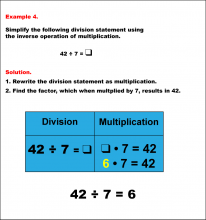
|
Math Example--Arithmetic--Division and Unknown Factors: Example 4 | Math Example--Arithmetic--Division and Unknown Factors: Example 4TopicArithmetic DescriptionSimplify 42 ÷ 7 by using the inverse operation of multiplication. The example illustrates the method of column multiplication. The caption explains the process step-by-step, emphasizing the sequential multiplication and any necessary regrouping. In general, column multiplication is a foundational arithmetic skill that develops a student's ability to handle larger numbers systematically. Examples in this collection present varied scenarios, building confidence through exposure to different configurations of numbers. |
Division Facts and Multiplication Facts |

|
Math Example--Arithmetic--Division and Unknown Factors: Example 4 | Math Example--Arithmetic--Division and Unknown Factors: Example 4TopicArithmetic DescriptionSimplify 42 ÷ 7 by using the inverse operation of multiplication. The example illustrates the method of column multiplication. The caption explains the process step-by-step, emphasizing the sequential multiplication and any necessary regrouping. In general, column multiplication is a foundational arithmetic skill that develops a student's ability to handle larger numbers systematically. Examples in this collection present varied scenarios, building confidence through exposure to different configurations of numbers. |
Division Facts and Multiplication Facts |

|
Math Example--Arithmetic--Division and Unknown Factors: Example 4 | Math Example--Arithmetic--Division and Unknown Factors: Example 4TopicArithmetic DescriptionSimplify 42 ÷ 7 by using the inverse operation of multiplication. The example illustrates the method of column multiplication. The caption explains the process step-by-step, emphasizing the sequential multiplication and any necessary regrouping. In general, column multiplication is a foundational arithmetic skill that develops a student's ability to handle larger numbers systematically. Examples in this collection present varied scenarios, building confidence through exposure to different configurations of numbers. |
Division Facts and Multiplication Facts |

|
Math Example--Arithmetic--Division and Unknown Factors: Example 4 | Math Example--Arithmetic--Division and Unknown Factors: Example 4TopicArithmetic DescriptionSimplify 42 ÷ 7 by using the inverse operation of multiplication. The example illustrates the method of column multiplication. The caption explains the process step-by-step, emphasizing the sequential multiplication and any necessary regrouping. In general, column multiplication is a foundational arithmetic skill that develops a student's ability to handle larger numbers systematically. Examples in this collection present varied scenarios, building confidence through exposure to different configurations of numbers. |
Division Facts and Multiplication Facts |

|
Math Example--Arithmetic--Division and Unknown Factors: Example 4 | Math Example--Arithmetic--Division and Unknown Factors: Example 4TopicArithmetic DescriptionSimplify 42 ÷ 7 by using the inverse operation of multiplication. The example illustrates the method of column multiplication. The caption explains the process step-by-step, emphasizing the sequential multiplication and any necessary regrouping. In general, column multiplication is a foundational arithmetic skill that develops a student's ability to handle larger numbers systematically. Examples in this collection present varied scenarios, building confidence through exposure to different configurations of numbers. |
Division Facts and Multiplication Facts |

|
Math Example--Arithmetic--Division and Unknown Factors: Example 4 | Math Example--Arithmetic--Division and Unknown Factors: Example 4TopicArithmetic DescriptionSimplify 42 ÷ 7 by using the inverse operation of multiplication. The example illustrates the method of column multiplication. The caption explains the process step-by-step, emphasizing the sequential multiplication and any necessary regrouping. In general, column multiplication is a foundational arithmetic skill that develops a student's ability to handle larger numbers systematically. Examples in this collection present varied scenarios, building confidence through exposure to different configurations of numbers. |
Division Facts and Multiplication Facts |

|
Math Example--Arithmetic--Division and Unknown Factors: Example 5 | Math Example--Arithmetic--Division and Unknown Factors: Example 5TopicArithmetic DescriptionSimplify 55 ÷ 5 by using the inverse operation of multiplication. The example illustrates the method of column multiplication. The caption explains the process step-by-step, emphasizing the sequential multiplication and any necessary regrouping. In general, column multiplication is a foundational arithmetic skill that develops a student's ability to handle larger numbers systematically. Examples in this collection present varied scenarios, building confidence through exposure to different configurations of numbers. |
Division Facts and Multiplication Facts |

|
Math Example--Arithmetic--Division and Unknown Factors: Example 5 | Math Example--Arithmetic--Division and Unknown Factors: Example 5TopicArithmetic DescriptionSimplify 55 ÷ 5 by using the inverse operation of multiplication. The example illustrates the method of column multiplication. The caption explains the process step-by-step, emphasizing the sequential multiplication and any necessary regrouping. In general, column multiplication is a foundational arithmetic skill that develops a student's ability to handle larger numbers systematically. Examples in this collection present varied scenarios, building confidence through exposure to different configurations of numbers. |
Division Facts and Multiplication Facts |

|
Math Example--Arithmetic--Division and Unknown Factors: Example 5 | Math Example--Arithmetic--Division and Unknown Factors: Example 5TopicArithmetic DescriptionSimplify 55 ÷ 5 by using the inverse operation of multiplication. The example illustrates the method of column multiplication. The caption explains the process step-by-step, emphasizing the sequential multiplication and any necessary regrouping. In general, column multiplication is a foundational arithmetic skill that develops a student's ability to handle larger numbers systematically. Examples in this collection present varied scenarios, building confidence through exposure to different configurations of numbers. |
Division Facts and Multiplication Facts |

|
Math Example--Arithmetic--Division and Unknown Factors: Example 5 | Math Example--Arithmetic--Division and Unknown Factors: Example 5TopicArithmetic DescriptionSimplify 55 ÷ 5 by using the inverse operation of multiplication. The example illustrates the method of column multiplication. The caption explains the process step-by-step, emphasizing the sequential multiplication and any necessary regrouping. In general, column multiplication is a foundational arithmetic skill that develops a student's ability to handle larger numbers systematically. Examples in this collection present varied scenarios, building confidence through exposure to different configurations of numbers. |
Division Facts and Multiplication Facts |

|
Math Example--Arithmetic--Division and Unknown Factors: Example 5 | Math Example--Arithmetic--Division and Unknown Factors: Example 5TopicArithmetic DescriptionSimplify 55 ÷ 5 by using the inverse operation of multiplication. The example illustrates the method of column multiplication. The caption explains the process step-by-step, emphasizing the sequential multiplication and any necessary regrouping. In general, column multiplication is a foundational arithmetic skill that develops a student's ability to handle larger numbers systematically. Examples in this collection present varied scenarios, building confidence through exposure to different configurations of numbers. |
Division Facts and Multiplication Facts |

|
Math Example--Arithmetic--Division and Unknown Factors: Example 5 | Math Example--Arithmetic--Division and Unknown Factors: Example 5TopicArithmetic DescriptionSimplify 55 ÷ 5 by using the inverse operation of multiplication. The example illustrates the method of column multiplication. The caption explains the process step-by-step, emphasizing the sequential multiplication and any necessary regrouping. In general, column multiplication is a foundational arithmetic skill that develops a student's ability to handle larger numbers systematically. Examples in this collection present varied scenarios, building confidence through exposure to different configurations of numbers. |
Division Facts and Multiplication Facts |
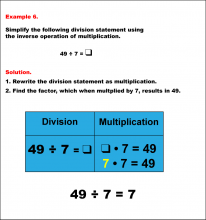
|
Math Example--Arithmetic--Division and Unknown Factors: Example 6 | Math Example--Arithmetic--Division and Unknown Factors: Example 6TopicArithmetic DescriptionSimplify 49 ÷ 7 by using the inverse operation of multiplication. The example illustrates the method of column multiplication. The caption explains the process step-by-step, emphasizing the sequential multiplication and any necessary regrouping. In general, column multiplication is a foundational arithmetic skill that develops a student's ability to handle larger numbers systematically. Examples in this collection present varied scenarios, building confidence through exposure to different configurations of numbers. |
Division Facts and Multiplication Facts |

|
Math Example--Arithmetic--Division and Unknown Factors: Example 6 | Math Example--Arithmetic--Division and Unknown Factors: Example 6TopicArithmetic DescriptionSimplify 49 ÷ 7 by using the inverse operation of multiplication. The example illustrates the method of column multiplication. The caption explains the process step-by-step, emphasizing the sequential multiplication and any necessary regrouping. In general, column multiplication is a foundational arithmetic skill that develops a student's ability to handle larger numbers systematically. Examples in this collection present varied scenarios, building confidence through exposure to different configurations of numbers. |
Division Facts and Multiplication Facts |

|
Math Example--Arithmetic--Division and Unknown Factors: Example 6 | Math Example--Arithmetic--Division and Unknown Factors: Example 6TopicArithmetic DescriptionSimplify 49 ÷ 7 by using the inverse operation of multiplication. The example illustrates the method of column multiplication. The caption explains the process step-by-step, emphasizing the sequential multiplication and any necessary regrouping. In general, column multiplication is a foundational arithmetic skill that develops a student's ability to handle larger numbers systematically. Examples in this collection present varied scenarios, building confidence through exposure to different configurations of numbers. |
Division Facts and Multiplication Facts |

|
Math Example--Arithmetic--Division and Unknown Factors: Example 6 | Math Example--Arithmetic--Division and Unknown Factors: Example 6TopicArithmetic DescriptionSimplify 49 ÷ 7 by using the inverse operation of multiplication. The example illustrates the method of column multiplication. The caption explains the process step-by-step, emphasizing the sequential multiplication and any necessary regrouping. In general, column multiplication is a foundational arithmetic skill that develops a student's ability to handle larger numbers systematically. Examples in this collection present varied scenarios, building confidence through exposure to different configurations of numbers. |
Division Facts and Multiplication Facts |

|
Math Example--Arithmetic--Division and Unknown Factors: Example 6 | Math Example--Arithmetic--Division and Unknown Factors: Example 6TopicArithmetic DescriptionSimplify 49 ÷ 7 by using the inverse operation of multiplication. The example illustrates the method of column multiplication. The caption explains the process step-by-step, emphasizing the sequential multiplication and any necessary regrouping. In general, column multiplication is a foundational arithmetic skill that develops a student's ability to handle larger numbers systematically. Examples in this collection present varied scenarios, building confidence through exposure to different configurations of numbers. |
Division Facts and Multiplication Facts |

|
Math Example--Arithmetic--Division and Unknown Factors: Example 6 | Math Example--Arithmetic--Division and Unknown Factors: Example 6TopicArithmetic DescriptionSimplify 49 ÷ 7 by using the inverse operation of multiplication. The example illustrates the method of column multiplication. The caption explains the process step-by-step, emphasizing the sequential multiplication and any necessary regrouping. In general, column multiplication is a foundational arithmetic skill that develops a student's ability to handle larger numbers systematically. Examples in this collection present varied scenarios, building confidence through exposure to different configurations of numbers. |
Division Facts and Multiplication Facts |

|
Math Example--Arithmetic--Division and Unknown Factors: Example 7 | Math Example--Arithmetic--Division and Unknown Factors: Example 7TopicArithmetic DescriptionSimplify 54 ÷ 6 by using the inverse operation of multiplication. The example illustrates the method of column multiplication. The caption explains the process step-by-step, emphasizing the sequential multiplication and any necessary regrouping. In general, column multiplication is a foundational arithmetic skill that develops a student's ability to handle larger numbers systematically. Examples in this collection present varied scenarios, building confidence through exposure to different configurations of numbers. |
Division Facts and Multiplication Facts |

|
Math Example--Arithmetic--Division and Unknown Factors: Example 7 | Math Example--Arithmetic--Division and Unknown Factors: Example 7TopicArithmetic DescriptionSimplify 54 ÷ 6 by using the inverse operation of multiplication. The example illustrates the method of column multiplication. The caption explains the process step-by-step, emphasizing the sequential multiplication and any necessary regrouping. In general, column multiplication is a foundational arithmetic skill that develops a student's ability to handle larger numbers systematically. Examples in this collection present varied scenarios, building confidence through exposure to different configurations of numbers. |
Division Facts and Multiplication Facts |

|
Math Example--Arithmetic--Division and Unknown Factors: Example 7 | Math Example--Arithmetic--Division and Unknown Factors: Example 7TopicArithmetic DescriptionSimplify 54 ÷ 6 by using the inverse operation of multiplication. The example illustrates the method of column multiplication. The caption explains the process step-by-step, emphasizing the sequential multiplication and any necessary regrouping. In general, column multiplication is a foundational arithmetic skill that develops a student's ability to handle larger numbers systematically. Examples in this collection present varied scenarios, building confidence through exposure to different configurations of numbers. |
Division Facts and Multiplication Facts |

|
Math Example--Arithmetic--Division and Unknown Factors: Example 7 | Math Example--Arithmetic--Division and Unknown Factors: Example 7TopicArithmetic DescriptionSimplify 54 ÷ 6 by using the inverse operation of multiplication. The example illustrates the method of column multiplication. The caption explains the process step-by-step, emphasizing the sequential multiplication and any necessary regrouping. In general, column multiplication is a foundational arithmetic skill that develops a student's ability to handle larger numbers systematically. Examples in this collection present varied scenarios, building confidence through exposure to different configurations of numbers. |
Division Facts and Multiplication Facts |

|
Math Example--Arithmetic--Division and Unknown Factors: Example 7 | Math Example--Arithmetic--Division and Unknown Factors: Example 7TopicArithmetic DescriptionSimplify 54 ÷ 6 by using the inverse operation of multiplication. The example illustrates the method of column multiplication. The caption explains the process step-by-step, emphasizing the sequential multiplication and any necessary regrouping. In general, column multiplication is a foundational arithmetic skill that develops a student's ability to handle larger numbers systematically. Examples in this collection present varied scenarios, building confidence through exposure to different configurations of numbers. |
Division Facts and Multiplication Facts |
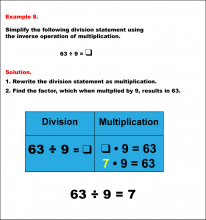
|
Math Example--Arithmetic--Division and Unknown Factors: Example 8 | Math Example--Arithmetic--Division and Unknown Factors: Example 8TopicArithmetic DescriptionSimplify 63 ÷ 9 by using the inverse operation of multiplication. The example illustrates the method of column multiplication. The caption explains the process step-by-step, emphasizing the sequential multiplication and any necessary regrouping. In general, column multiplication is a foundational arithmetic skill that develops a student's ability to handle larger numbers systematically. Examples in this collection present varied scenarios, building confidence through exposure to different configurations of numbers. |
Division Facts and Multiplication Facts |

|
Math Example--Arithmetic--Division and Unknown Factors: Example 8 | Math Example--Arithmetic--Division and Unknown Factors: Example 8TopicArithmetic DescriptionSimplify 63 ÷ 9 by using the inverse operation of multiplication. The example illustrates the method of column multiplication. The caption explains the process step-by-step, emphasizing the sequential multiplication and any necessary regrouping. In general, column multiplication is a foundational arithmetic skill that develops a student's ability to handle larger numbers systematically. Examples in this collection present varied scenarios, building confidence through exposure to different configurations of numbers. |
Division Facts and Multiplication Facts |

|
Math Example--Arithmetic--Division and Unknown Factors: Example 8 | Math Example--Arithmetic--Division and Unknown Factors: Example 8TopicArithmetic DescriptionSimplify 63 ÷ 9 by using the inverse operation of multiplication. The example illustrates the method of column multiplication. The caption explains the process step-by-step, emphasizing the sequential multiplication and any necessary regrouping. In general, column multiplication is a foundational arithmetic skill that develops a student's ability to handle larger numbers systematically. Examples in this collection present varied scenarios, building confidence through exposure to different configurations of numbers. |
Division Facts and Multiplication Facts |

|
Math Example--Arithmetic--Division and Unknown Factors: Example 8 | Math Example--Arithmetic--Division and Unknown Factors: Example 8TopicArithmetic DescriptionSimplify 63 ÷ 9 by using the inverse operation of multiplication. The example illustrates the method of column multiplication. The caption explains the process step-by-step, emphasizing the sequential multiplication and any necessary regrouping. In general, column multiplication is a foundational arithmetic skill that develops a student's ability to handle larger numbers systematically. Examples in this collection present varied scenarios, building confidence through exposure to different configurations of numbers. |
Division Facts and Multiplication Facts |

|
Math Example--Arithmetic--Division and Unknown Factors: Example 8 | Math Example--Arithmetic--Division and Unknown Factors: Example 8TopicArithmetic DescriptionSimplify 63 ÷ 9 by using the inverse operation of multiplication. The example illustrates the method of column multiplication. The caption explains the process step-by-step, emphasizing the sequential multiplication and any necessary regrouping. In general, column multiplication is a foundational arithmetic skill that develops a student's ability to handle larger numbers systematically. Examples in this collection present varied scenarios, building confidence through exposure to different configurations of numbers. |
Division Facts and Multiplication Facts |

|
Math Example--Arithmetic--Division and Unknown Factors: Example 8 | Math Example--Arithmetic--Division and Unknown Factors: Example 8TopicArithmetic DescriptionSimplify 63 ÷ 9 by using the inverse operation of multiplication. The example illustrates the method of column multiplication. The caption explains the process step-by-step, emphasizing the sequential multiplication and any necessary regrouping. In general, column multiplication is a foundational arithmetic skill that develops a student's ability to handle larger numbers systematically. Examples in this collection present varied scenarios, building confidence through exposure to different configurations of numbers. |
Division Facts and Multiplication Facts |
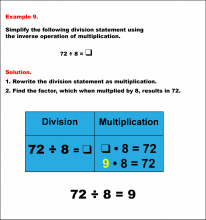
|
Math Example--Arithmetic--Division and Unknown Factors: Example 9 | Math Example--Arithmetic--Division and Unknown Factors: Example 9TopicArithmetic DescriptionSimplify 72 ÷ 8 by using the inverse operation of multiplication. The example illustrates the method of column multiplication. The caption explains the process step-by-step, emphasizing the sequential multiplication and any necessary regrouping. In general, column multiplication is a foundational arithmetic skill that develops a student's ability to handle larger numbers systematically. Examples in this collection present varied scenarios, building confidence through exposure to different configurations of numbers. |
Division Facts and Multiplication Facts |

|
Math Example--Arithmetic--Division and Unknown Factors: Example 9 | Math Example--Arithmetic--Division and Unknown Factors: Example 9TopicArithmetic DescriptionSimplify 72 ÷ 8 by using the inverse operation of multiplication. The example illustrates the method of column multiplication. The caption explains the process step-by-step, emphasizing the sequential multiplication and any necessary regrouping. In general, column multiplication is a foundational arithmetic skill that develops a student's ability to handle larger numbers systematically. Examples in this collection present varied scenarios, building confidence through exposure to different configurations of numbers. |
Division Facts and Multiplication Facts |

|
Math Example--Arithmetic--Division and Unknown Factors: Example 9 | Math Example--Arithmetic--Division and Unknown Factors: Example 9TopicArithmetic DescriptionSimplify 72 ÷ 8 by using the inverse operation of multiplication. The example illustrates the method of column multiplication. The caption explains the process step-by-step, emphasizing the sequential multiplication and any necessary regrouping. In general, column multiplication is a foundational arithmetic skill that develops a student's ability to handle larger numbers systematically. Examples in this collection present varied scenarios, building confidence through exposure to different configurations of numbers. |
Division Facts and Multiplication Facts |

|
Math Example--Arithmetic--Division and Unknown Factors: Example 9 | Math Example--Arithmetic--Division and Unknown Factors: Example 9TopicArithmetic DescriptionSimplify 72 ÷ 8 by using the inverse operation of multiplication. The example illustrates the method of column multiplication. The caption explains the process step-by-step, emphasizing the sequential multiplication and any necessary regrouping. In general, column multiplication is a foundational arithmetic skill that develops a student's ability to handle larger numbers systematically. Examples in this collection present varied scenarios, building confidence through exposure to different configurations of numbers. |
Division Facts and Multiplication Facts |

|
Math Example--Arithmetic--Division and Unknown Factors: Example 9 | Math Example--Arithmetic--Division and Unknown Factors: Example 9TopicArithmetic DescriptionSimplify 72 ÷ 8 by using the inverse operation of multiplication. The example illustrates the method of column multiplication. The caption explains the process step-by-step, emphasizing the sequential multiplication and any necessary regrouping. In general, column multiplication is a foundational arithmetic skill that develops a student's ability to handle larger numbers systematically. Examples in this collection present varied scenarios, building confidence through exposure to different configurations of numbers. |
Division Facts and Multiplication Facts |

|
Math Example--Arithmetic--Division and Unknown Factors: Example 9 | Math Example--Arithmetic--Division and Unknown Factors: Example 9TopicArithmetic DescriptionSimplify 72 ÷ 8 by using the inverse operation of multiplication. The example illustrates the method of column multiplication. The caption explains the process step-by-step, emphasizing the sequential multiplication and any necessary regrouping. In general, column multiplication is a foundational arithmetic skill that develops a student's ability to handle larger numbers systematically. Examples in this collection present varied scenarios, building confidence through exposure to different configurations of numbers. |
Division Facts and Multiplication Facts |
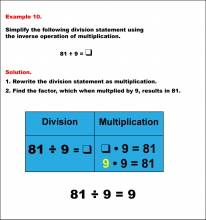
|
Math Example--Arithmetic--Division and Unknown Factors: Example 10 | Math Example--Arithmetic--Division and Unknown Factors: Example 10TopicArithmetic DescriptionSimplify 81 ÷ 9 by using the inverse operation of multiplication. The example illustrates the method of column multiplication. The caption explains the process step-by-step, emphasizing the sequential multiplication and any necessary regrouping. In general, column multiplication is a foundational arithmetic skill that develops a student's ability to handle larger numbers systematically. Examples in this collection present varied scenarios, building confidence through exposure to different configurations of numbers. |
Division Facts and Multiplication Facts |

|
Math Example--Arithmetic--Division and Unknown Factors: Example 10 | Math Example--Arithmetic--Division and Unknown Factors: Example 10TopicArithmetic DescriptionSimplify 81 ÷ 9 by using the inverse operation of multiplication. The example illustrates the method of column multiplication. The caption explains the process step-by-step, emphasizing the sequential multiplication and any necessary regrouping. In general, column multiplication is a foundational arithmetic skill that develops a student's ability to handle larger numbers systematically. Examples in this collection present varied scenarios, building confidence through exposure to different configurations of numbers. |
Division Facts and Multiplication Facts |

|
Math Example--Arithmetic--Division and Unknown Factors: Example 10 | Math Example--Arithmetic--Division and Unknown Factors: Example 10TopicArithmetic DescriptionSimplify 81 ÷ 9 by using the inverse operation of multiplication. The example illustrates the method of column multiplication. The caption explains the process step-by-step, emphasizing the sequential multiplication and any necessary regrouping. In general, column multiplication is a foundational arithmetic skill that develops a student's ability to handle larger numbers systematically. Examples in this collection present varied scenarios, building confidence through exposure to different configurations of numbers. |
Division Facts and Multiplication Facts |

|
Math Example--Arithmetic--Division and Unknown Factors: Example 10 | Math Example--Arithmetic--Division and Unknown Factors: Example 10TopicArithmetic DescriptionSimplify 81 ÷ 9 by using the inverse operation of multiplication. The example illustrates the method of column multiplication. The caption explains the process step-by-step, emphasizing the sequential multiplication and any necessary regrouping. In general, column multiplication is a foundational arithmetic skill that develops a student's ability to handle larger numbers systematically. Examples in this collection present varied scenarios, building confidence through exposure to different configurations of numbers. |
Division Facts and Multiplication Facts |

|
Math Example--Arithmetic--Division and Unknown Factors: Example 10 | Math Example--Arithmetic--Division and Unknown Factors: Example 10TopicArithmetic DescriptionSimplify 81 ÷ 9 by using the inverse operation of multiplication. The example illustrates the method of column multiplication. The caption explains the process step-by-step, emphasizing the sequential multiplication and any necessary regrouping. In general, column multiplication is a foundational arithmetic skill that develops a student's ability to handle larger numbers systematically. Examples in this collection present varied scenarios, building confidence through exposure to different configurations of numbers. |
Division Facts and Multiplication Facts |